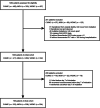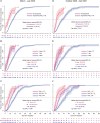Prolonged Unconsciousness is Common in COVID-19 and Associated with Hypoxemia
- PMID: 35254675
- PMCID: PMC9082460
- DOI: 10.1002/ana.26342
Prolonged Unconsciousness is Common in COVID-19 and Associated with Hypoxemia
Abstract
Objective: The purpose of this study was to estimate the time to recovery of command-following and associations between hypoxemia with time to recovery of command-following.
Methods: In this multicenter, retrospective, cohort study during the initial surge of the United States' pandemic (March-July 2020) we estimate the time from intubation to recovery of command-following, using Kaplan Meier cumulative-incidence curves and Cox proportional hazard models. Patients were included if they were admitted to 1 of 3 hospitals because of severe coronavirus disease 2019 (COVID-19), required endotracheal intubation for at least 7 days, and experienced impairment of consciousness (Glasgow Coma Scale motor score <6).
Results: Five hundred seventy-one patients of the 795 patients recovered command-following. The median time to recovery of command-following was 30 days (95% confidence interval [CI] = 27-32 days). Median time to recovery of command-following increased by 16 days for patients with at least one episode of an arterial partial pressure of oxygen (PaO2 ) value ≤55 mmHg (p < 0.001), and 25% recovered ≥10 days after cessation of mechanical ventilation. The time to recovery of command-following was associated with hypoxemia (PaO2 ≤55 mmHg hazard ratio [HR] = 0.56, 95% CI = 0.46-0.68; PaO2 ≤70 HR = 0.88, 95% CI = 0.85-0.91), and each additional day of hypoxemia decreased the likelihood of recovery, accounting for confounders including sedation. These findings were confirmed among patients without any imagining evidence of structural brain injury (n = 199), and in a non-overlapping second surge cohort (N = 427, October 2020 to April 2021).
Interpretation: Survivors of severe COVID-19 commonly recover consciousness weeks after cessation of mechanical ventilation. Long recovery periods are associated with more severe hypoxemia. This relationship is not explained by sedation or brain injury identified on clinical imaging and should inform decisions about life-sustaining therapies. ANN NEUROL 2022;91:740-755.
© 2022 The Authors. Annals of Neurology published by Wiley Periodicals LLC on behalf of American Neurological Association.
Conflict of interest statement
David A. Berlin has been compensated for consulting and serving on safety monitoring board for a Bristol Myers Squib study of a therapy for severe COVID‐19. No other potential conflicts of interests by any authors.
Figures





Comment in
-
Inappropriateness of the Glasgow Coma Scale for Consciousness Assessment in COVID-19 Patients.Ann Neurol. 2022 Nov;92(5):906. doi: 10.1002/ana.26476. Epub 2022 Aug 26. Ann Neurol. 2022. PMID: 35960230 Free PMC article. No abstract available.
References
-
- World Health Organization (WHO) . Coronavirus disease 2019 (COVID‐19) weekly epidemiological update ‐ 5 October 2021. Available at: https://www.who.int/publications/m/item/weekly-epidemiological-update-on... [October 6, 2021]. Available at: https://www.who.int/publications/m/item/weekly-epidemiological-update-on...
-
- Berlin DA, Gulick RM, Martinez FJ. Severe Covid‐19. N Engl J Med 2020;383:2451–2460. - PubMed
Publication types
MeSH terms
Grants and funding
LinkOut - more resources
Full Text Sources
Medical
Miscellaneous

